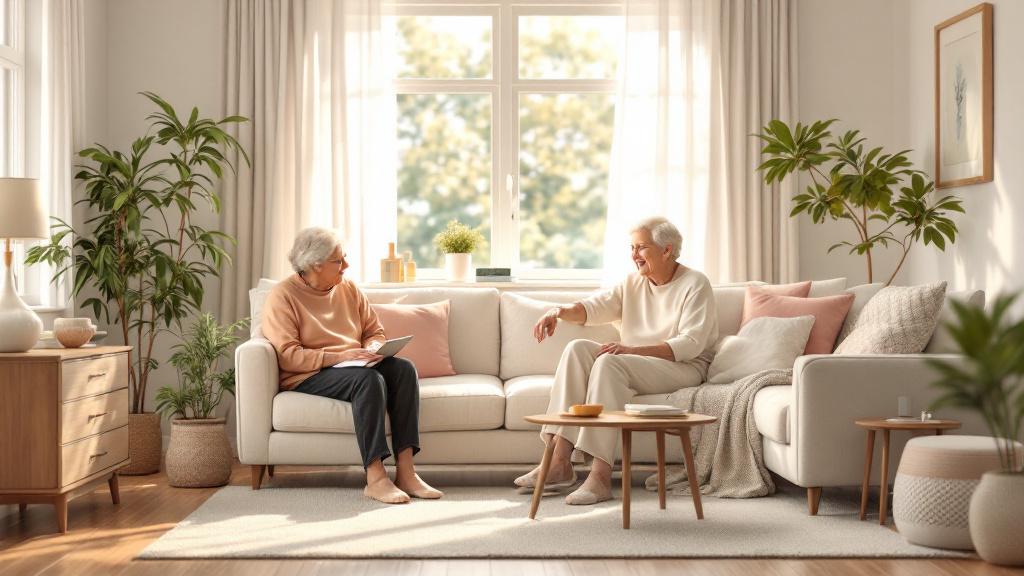The Benefits of Physical Activity for Nursing Home Residents
Discover the benefits of physical activity for nursing home residents and elevate their wellbeing today!
.jpg)
Importance of Physical Activity in Nursing Homes
Engaging in physical activity is vital for the overall wellbeing of nursing home residents. Activities not only promote health but also foster social connections and enhance quality of life.

Why Physical Activity Matters in Nursing Homes
Regular physical activity plays a crucial role in maintaining the health and vitality of elderly residents. It aids in the prevention of various health issues commonly faced by older adults. Here are some key reasons why physical activity is essential:
Importance of Physical ActivityExplanationReduces Risk of Chronic DiseasesRegular exercise can decrease the likelihood of conditions such as heart disease, diabetes, and obesity.Improves Cardiovascular HealthPhysical activity strengthens the heart and improves circulation.Enhances Muscle Strength and FlexibilityWeight-bearing exercises help maintain muscle mass and joint flexibility.Supports Mental HealthExercise is linked to reduced symptoms of depression and anxiety.
Impact of Physical Activity on Elderly Residents
The effects of physical activity on the health and wellbeing of nursing home residents are profound. It contributes not only to physical health but also positively influences emotional and social aspects of life. Key impacts include:
Impact of Physical ActivityBenefitsIncreases LongevityActive residents often enjoy longer lifespans compared to their sedentary peers.Enhances MoodRegular exercise can elevate mood and decrease feelings of loneliness.Encourages Social InteractionGroup activities foster relationships and community bonding.Improves Sleep QualityPhysical activity is associated with better sleep patterns.
Understanding the benefits of physical activity for nursing home residents is fundamental in creating an environment that promotes healthy aging. By prioritizing physical activity, nursing homes can enhance the quality of life for their residents and support their overall wellbeing.
Physical and Mental Health Benefits
Engaging in physical activity offers numerous benefits for nursing home residents that significantly enhance their overall well-being. These advantages can be grouped into two main categories: physical health benefits and mental health benefits.
Physical Health Benefits
Regular physical activity is instrumental in maintaining and improving the physical health of elderly residents in nursing homes. Some key benefits include:
BenefitDescriptionImproved Cardiovascular HealthRegular exercise helps strengthen the heart and improve circulation.Enhanced Muscle StrengthPhysical activity promotes muscle mass retention and strength, which declines with age.Better Joint FlexibilityEngaging in stretching and low-impact exercises can improve flexibility and reduce stiffness.Weight ManagementRegular exercise assists in maintaining a healthy weight, which can prevent various chronic illnesses.Reduced Risk of Chronic DiseasesPhysical activity lowers the risk of diseases such as diabetes, hypertension, and osteoporosis.
Mental Health Benefits
Beyond physical gains, exercise profoundly impacts mental health, contributing to emotional stability and psychological wellness. Benefits include:
BenefitDescriptionDecreased DepressionParticipation in regular physical activity can lower symptoms of depression and anxiety.Enhanced MoodExercise releases endorphins, naturally uplifting mood and promoting feelings of happiness.Improved Sleep QualityRegular engagement in physical activity helps enhance sleep patterns and quality.Cognitive FunctionExercise stimulates brain function, potentially slowing cognitive decline in elderly individuals.Stress ReliefPhysical activity serves as a natural outlet for relieving stress and tension.
Improving Quality of Life through Physical Activity
The combined physical and mental health benefits of exercise greatly contribute to a higher quality of life for nursing home residents. Key elements to consider include:
FactorDescriptionIncreased Energy LevelsRegular activity boosts overall energy levels, enabling residents to participate in more activities.Enhanced Social InteractionEngaging in group exercises or activities helps foster connections among residents, reducing feelings of isolation.Greater IndependenceImproved mobility and strength allow residents to perform daily tasks more effectively, promoting autonomy.Overall WellnessThe combined physical and mental health benefits lead to an overall sense of well-being and contentment in life.
Through these varied advantages, physical activity stands as a crucial element in enhancing the health and quality of life for residents in nursing homes.
Social Interaction and Community Building
Promoting social interaction and a sense of community among nursing home residents is vital for enhancing overall well-being. Engaging in physical activity not only improves health but also encourages meaningful connections among individuals.
Encouraging Social Interaction
Physical activities in nursing homes create opportunities for residents to interact with one another. Group exercises, fitness classes, and organized sports not only focus on physical health but also foster chat and camaraderie. These interactions can help reduce feelings of isolation and loneliness, which are common among elderly residents.
The following table highlights the various activities that facilitate social engagement:
Activity TypeSocial Interaction OpportunitiesGroup ExercisesParticipants can motivate each otherDance ClassesPartners can connect through musicWalking ClubsPairs can spend time together while walkingTeam SportsPromotes teamwork and collaboration
Fostering a Sense of Community
Regular participation in group physical activities enhances the feeling of belonging among nursing home residents. When individuals engage with their peers in a supportive environment, it fosters a stronger community bond. A sense of community is essential for mental health, improving resident satisfaction and overall quality of life.
The table below showcases how physical activity contributes to building a community sense:
BenefitDescriptionShared ExperiencesResidents create lasting memories togetherSupport NetworksEncouragement and support from peersImproved RelationshipsEnhanced friendships through collaborationEmpathy and UnderstandingResidents learn from each other's experiences
By focusing on the benefits of physical activity for nursing home residents, facilities can implement programs that not only promote health but also enhance social interactions, fostering a vibrant community atmosphere.
Increased Mobility and Independence
Physical activity plays a vital role in promoting mobility and independence among nursing home residents. By engaging in regular exercise, residents can enhance their physical abilities and maintain their autonomy in daily life.
Enhancing Mobility Through Exercise
Exercise can significantly boost the mobility of elderly individuals. It strengthens muscles, improves balance, and increases flexibility, allowing residents to move more freely and safely. Regular physical activity can reduce the risk of falls, a common concern for seniors.
Exercise TypeMobility BenefitFrequency for Best ResultsStrength TrainingBuilds muscle mass and strength2-3 times per weekBalance ExercisesImproves stability and coordinationDaily or several times per weekFlexibility RoutinesIncreases range of motionDailyAerobic ActivitiesEnhances overall endurance3-5 times per week
Promoting Independence in Daily Activities
As residents improve their mobility through exercise, they often find it easier to perform daily tasks, leading to increased independence. Activities such as dressing, bathing, and walking can become more manageable with enhanced physical capabilities.
Daily ActivityIndependence ImprovementRelated Exercise TypeDressingGreater ease in getting dressedStrength trainingBathingIncreased ability to bathe aloneFlexibility routinesWalkingEnhanced ability to move aroundAerobic activitiesMeal PreparationMore confidence in cookingBalance exercises
By incorporating regular physical activity into their routines, nursing home residents not only enhance their mobility but also foster a greater sense of independence in their daily lives. This empowerment is essential for improving their overall quality of life.
Cognitive Benefits of Physical Activity
Engaging in physical activity offers numerous cognitive advantages for nursing home residents. Regular exercise has been shown to stimulate brain function and contribute positively to mental agility and overall cognitive health.
Stimulating Cognitive Function
Physical activity can enhance various cognitive functions, such as memory, attention, and problem-solving skills. Exercise increases blood flow to the brain, which can promote the growth of new brain cells and improve connections between existing cells. This stimulation is crucial for maintaining cognitive clarity, especially in older adults.
Studies have demonstrated that even moderate physical activity can lead to improvements in cognitive abilities. Activities like walking, dancing, or group exercises can provide cognitive stimulation while engaging residents.
Type of ActivityCognitive Function ImprovementAerobic ExercisesMemory, AttentionStrength TrainingProblem-SolvingFlexibility ExercisesCoordination, Balance
Maintaining Mental Sharpness
Consistent engagement in physical activity has a direct relationship with maintaining mental sharpness. Regular exercise routines can delay the onset of cognitive decline and may help protect against conditions such as dementia and Alzheimer's disease.
Research indicates that nursing home residents who participate in regular physical activity report better mental health, enhanced mood, and improved overall well-being. This ongoing engagement in physical fitness can support a more active mind and sharper thinking as individuals age.
Frequency of ExerciseMental Sharpness Level1-2 times a weekLow3-4 times a weekModerate5 or more times a weekHigh
Physical activity serves as a vital component in promoting cognitive benefits for nursing home residents. Incorporating exercise into daily routines can help to enhance mental agility and contribute to a healthier, more fulfilling lifestyle.
Implementing Physical Activity Programs
Creating effective physical activity programs for nursing home residents requires careful consideration of individual needs and professional expertise. By tailoring exercise routines to meet specific requirements, facilities can significantly enhance the physical, mental, and social wellbeing of their residents.
Tailoring Exercise Programs to Residents' Needs
Each resident's physical abilities, health conditions, and personal preferences play a crucial role in designing an appropriate exercise program. Customization ensures that activities are both safe and enjoyable. Here are some key factors to consider when developing tailored programs:
FactorDescriptionPhysical AbilityAssessing mobility levels, strength, and endurance to determine suitable exercisesMedical ConditionsConsulting with healthcare professionals to account for any health issues, such as arthritis or heart conditionsInterest LevelsEngaging residents in discussions about preferred activities to increase participation and motivationGroup DynamicsCreating opportunities for socialization by organizing group exercises or activities that encourage camaraderie
Importance of Professional Guidance
Incorporating professional guidance is essential for the success of physical activity programs in nursing homes. Trained instructors or physical therapists can ensure that exercises are conducted safely and effectively. Key aspects of professional involvement include:
Role of ProfessionalsBenefitsExercise AssessmentEvaluating residents' fitness levels and medical histories to guide program developmentSupervisionProviding oversight during activities to prevent injuries and ensure correct techniquesMotivationEncouraging residents to stay consistent with their exercise routines and setting achievable goalsAdaptationModifying exercises as residents progress or if their health conditions change to ensure ongoing effectiveness
By tailoring physical activity programs to the unique needs of nursing home residents and involving healthcare professionals, facilities can maximize the benefits of physical activity for their residents. This approach not only enhances physical health but also supports mental wellbeing and social connection among them.

How to Plan for Long-Term Home Care Services

How Home Team Helps Families Make Informed Care Decisions

How Home Team's Caregivers Provide Peace of Mind for Families



